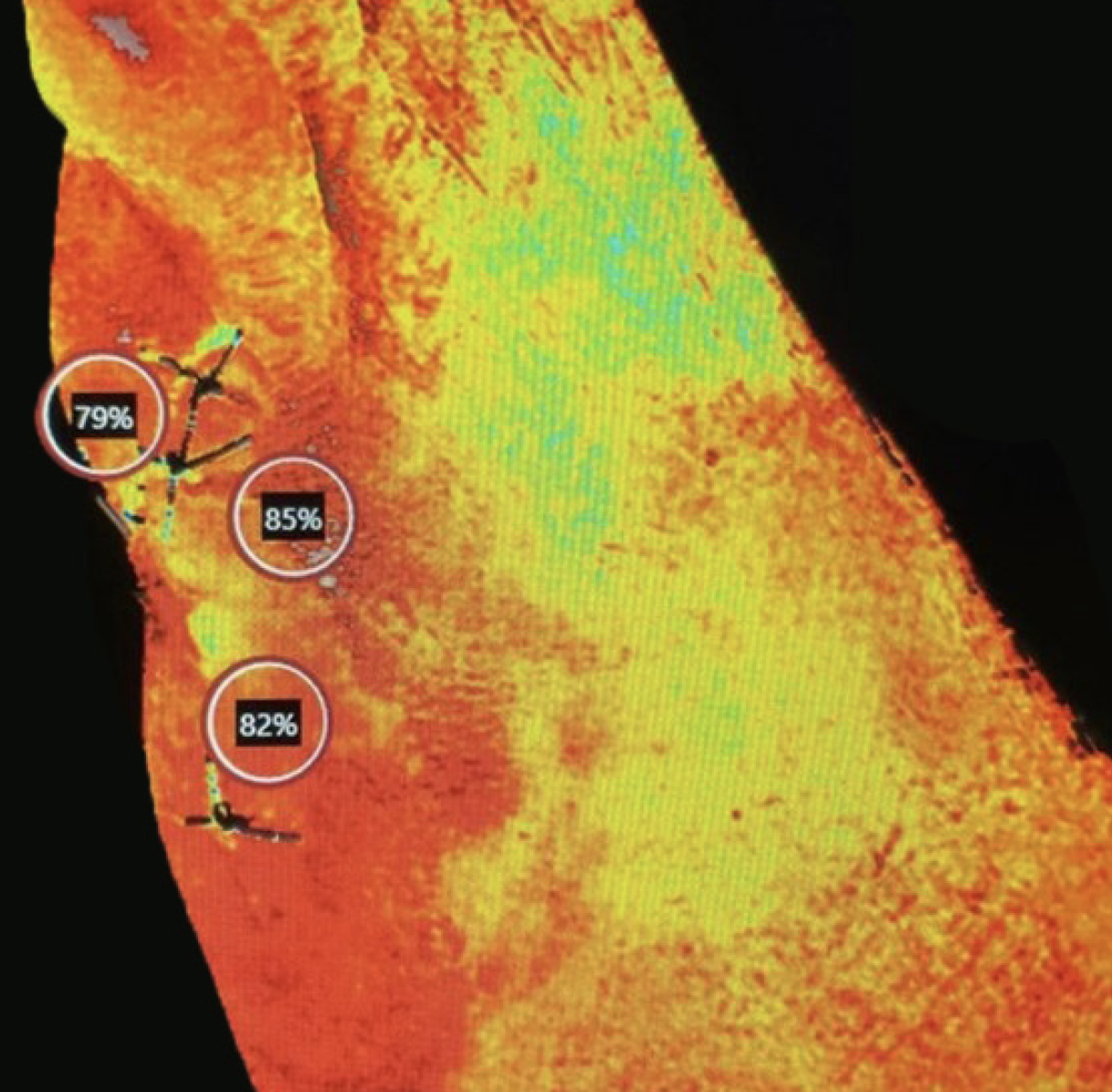THE EFFICACY OF NEAR-INFRARED SPECTROSCOPY IN EVALUATION OF HEALING POTENTIAL IN LIMB SALVAGE SURGERY
Ryan Chatelain, DPM and Michael McCollum, DPM
METHOD: SnapshotNIR near-infrared spectroscopy (NIRS) imaging was used over one month to evaluate pre- and post-operative limb salvage sites. Two limb salvage patients were selected with criteria that included critical limb ischemia. Both had undergone at least one peripheral intervention that was either only partially successful or unsuccessful. Both patients also had infected wounds in need of surgical intervention. Each patient was evaluated pre-operatively with the NIRS device to determine the viability of tissues locally and at proposed amputation sites. Based on the results of NIRS imaging, as well as other vascular studies including ankle-brachial indices and angiography, we determined which wounds were likely to heal and which were likely to require further amputation.
CASE 1
PATIENT DETAILS
A 67-year-old male patient with a history of diabetes, chronic peripheral vascular disease, ischemic cardiomyopathy, and esophageal cancer with a four-month history of a non-healing wound to the left fifth metatarsal head and underlying osteomyelitis noted on imaging. He was status-post a left iliac stent for severe stenosis with a history of bilateral superficial femoral artery occlusion that could not be revascularized. He was found to have monophasic waveforms to pedal arteries with a toe-brachial index of 0.18 representing severe distal disease.
CASE DETAILS
The patient required fifth toe and metatarsal amputation due to progressive osteomyelitis and the need to eradicate infection before he could undergo chemotherapy for esophageal cancer. SnapshotNIR was used to determine wound oxygenated hemoglobin levels at the proposed operative site to determine the healing potential of the amputation. The device indicated that the proposed site showed adequate oxygenated hemoglobin levels and the amputation was performed. The device was then used post-operatively to evaluate post-operative oxygenation which continued to show adequate oxygenation and tissue perfusion.
IMPACT
In this instance, SnapshotNIR was able to indicate that the patient, despite having non-operable significant proximal occlusion and severe digital ischemia, had healing potential. As we followed the patient post-operatively, this finding was serially confirmed via the imaging device and the patient went on to heal his wound and obtain much-needed chemotherapy for his esophageal cancer.
StO2 image indicating adequate oxygenation to post-op partial fifth ray amputation site.
CASE 2
PATIENT DETAILS
The patient is a 63-year-old male with a history of diabetes with neuropathy, coronary artery disease, and current cigarette use. He initially presented with monophasic ABIs in the 0.30 range and wet gangrenous second and third toes.
CASE DETAILS
The patient underwent angioplasty of the extremity and amputation of the second and third toes. The angioplasty failed, with toe amputation sites becoming dry gangrenous over a three-day period. Subsequent femoral-popliteal bypass was performed.
The vascular surgeon reported limited perfusion past the ankle level following the bypass but believed that a trans-metatarsal amputation would heal. The trans-metatarsal amputation was performed, and within three days, the site became dry gangrenous at the margins of the stump. At this point, the question became whether a more proximal foot amputation would heal or if the patient required a below-knee amputation (BKA).
SnapshotNIR imaging was used at this juncture with results indicating extremely poor oxygenation in the remainder of the foot. As a result, a more proximal foot amputation was recommended and performed. The patient experienced slow healing at the BKA site with poor microvascular signs even at this level.
IMPACT
SnapshotNIR imaging was able to predict via tissue oxygenation assessment that the foot was non-viable at any level.
StO2 image indicating poor oxygenation to potential midfoot/proximal foot amputation sites.
“With continued successful studies, NIRS could one day play an integral part in developing limb salvage protocol.”


